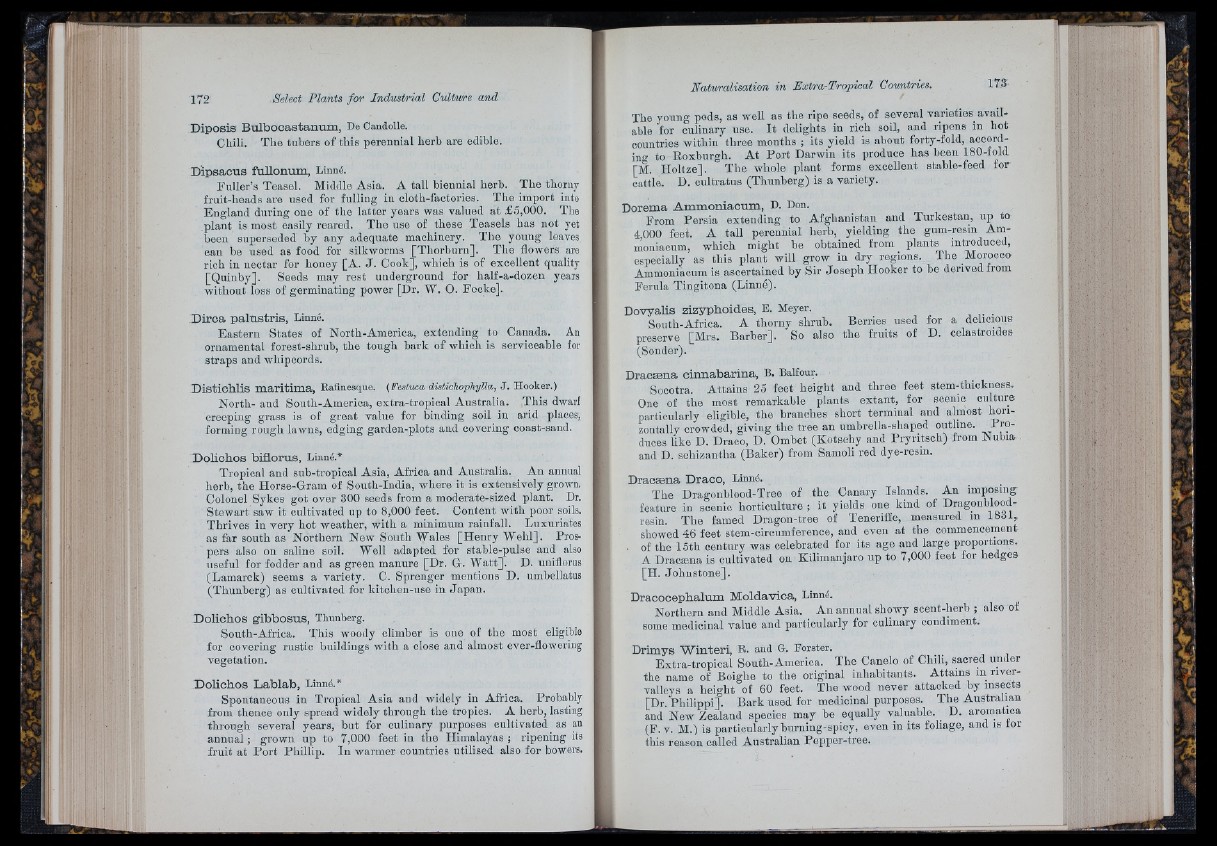
172 Select Plants fo r Industrial Culture and
D ip o s is B u lb o c a s ta n um , De Candolle.
Chili. The tubers of this perennial herb are edible.
D ip s a c u s fuUonum, Linné.
Fuller’s Teasel. Middle Asia. A tall biennial herb. The thorny
fruit-lieads are used for fulling in cloth-factories. The import into
England during one of the latter years was valued a t £5,000. The
plant is most easily reared. The use of these Teasels has not yet
been superseded by any adequate machinery. The young leaves
ean he used as food for silkworms [Thorbuni], The flowers are
rich in neotar for honey [A. J . Cook], which is of excellent quality
[Quinby]. Seeds may rest underground for half-a-dozen years
without loss of germinating power [Dr. W. O. Focke].
D irc a p a ln s tr is , Linné.
Eastern States of North-America, extending to Canada. An
ornamental forest-shrub, the tough bark of which is serviceable for
straps and whipcords.
D is tic h lis m a r itim a , Rafineaque. (Pestuca distichophylla, J. Hooker.)
North- and South-America, extra-tropical Australia. This dwarf
creeping grass is of great value for binding soil in arid places,
forming rough lawns, edging garden-plots and covering coast-sand.
D o lich o s b iñ o ru s , Linné.*
Tropical aud snb-tropical Asia, Africa and Australia. An annual
herb, the Horse-Gram of South-India, where it is extensively grown,
Colonel Sykes got over 300 seeds from a moderate-sized plant. Dr.
Stewart saw it cultivated up to 8,000 feet. Content with poor soils.
Thrives in very hot weather, with a minimum rainfall. Luxuriates
as far south as Northern New South Wales [Henry Wehl]. Prospers
also on saline soil. Well adapted for stable-pulse and also
useful for fodder and as green manure [Dr. G. Wa tt]. D. unifloras
(Lamarck) seems a variety. C. Sprenger mentions D. umbellatus
(Thunberg) as cultivated for kitchen-use in Japan.
D o lic h o s g ib b o su s , Thunberg.
South-Africa. This woody climber is one of the most eligible
for covering rustic buildings with a close and almost ever-flowering
vegetation.
D o lic h o s L a b la b , Linné.*
Spontaneous in Tropical Asia and widely in Africa. Probably
from thence only spread widely through the tropics. A herb, lasting
through several years, but for culinary purposes cultivated as an
annual ; grown up to 7,000 feet in the Himalayas ; ripening its
fruit at P o rt Phillip. In warmer countries utilised also for bowers.
Naturalisation in Extra-Tropical Countries. 173
The young pods, as well as the ripe seeds, of several varieties^ available
for culinary nse. I t delights in rich soil, and ripens in hot
countries within three months ; its yield is about forty-fold, according
to Roxburgh. A t P o rt Darwin its produce has been 180-fold
[M. Holtze]. The whole plant forms excellent stable-feed for
cattle. D. cultratus (Thunberg) is a variety.
Dorema A m m o n ia c um , D. Don.
From Persia extending to Afghanistan and Turkestan, up to
4,000 feet. A tall perennial herb, yielding the gum-resin Ammoniacum,
which might he obtained from plants introduced,
especially as this plant will grow in dry regions. The Morocco
Ammoniacum is ascertained by Sir Joseph Hooker to be derived from
Ferula Tingitona (Linné).
Dovyalis z izy p h o id e s, E. Meyer. _
South-Africa. A thorny shrub. Berries used for a delicious
preserve [Mrs. Barber]. So also the fruits of D. celastroides
(Sonder).
D ra cæ n a c in n a b a rin a , B. Balfour.
Socotra. Attains 25 feet height and three feet stemJliiokness.
One of the most remarkable plants extant, for scenic culture
particularly eligible, the branches short terminal and almost horizontally
crowded, giving the tree an umbrella-shaped outline. 1 >’o-
diices like D. Draco, D. Omhet (Kotschy and Pryritsch) from Nubia
and D. schizantha (Baker) from Samoli red dye-resin.
D ra cæ n a D ra co , Linné.
The Dragonblood-Tree of the Canary Islands. An imposing
feature in scenic horticulture ; it yields one kind of Dragonblood-
resin. The famed Dragon-tree of Teneriffe, measured in 1831,,
showed 46 feet stem-circumference, and even a t the commencement
. of the 15th century was celebrated for its age and large proportions.
A Dracæna is cultivated on Kilimanjaro up to 7,000 feet for hedges
[H. Johnstone],
D ra c o c e p h a lum M o ld áv ic a , Linné.
Northern and Middle Asia. An annual showy scent-herb ; also of
some medicinal value and particularly for culinary condiment.
Drimys "Winteri, R. and G. Forster.
Extra-tropical South-America. The Canelo of Chili, sacred under
the name of Boighe to the original inhabitants. Attains in river-
valleys a height of 60 feet. The wood never attacked by insects
[Dr. Philippi]. Bark nsed for medicinal purposes. The Australian
and New Zealand species may be equally valuable. D. aromatica
(F. V. M.) is partioularly burning-spicy, even in its foliage, and is tor
this reason called Australian Pepper-tree.
1^1